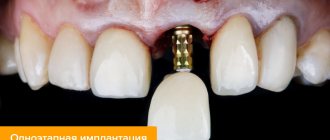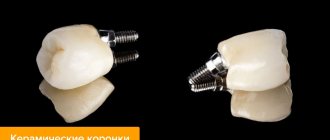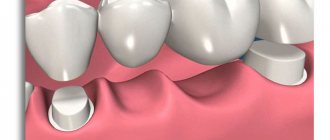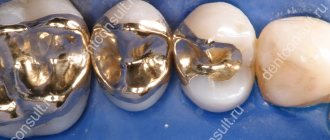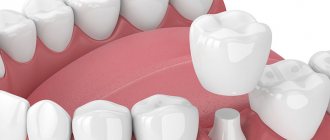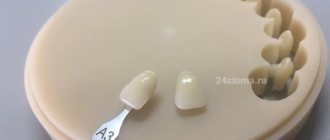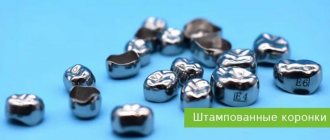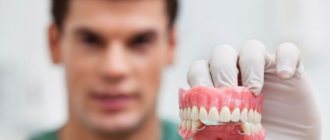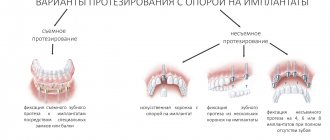Today we will talk about orthodontic structures such as temporary crowns .
We will discuss their features, types, indications for use, functional characteristics, materials from which they are made and installation steps.
We will also pay attention to the service life of these prostheses, why they are needed and much more on this topic.
Temporary crowns are a separate type of dental elements that are installed in place of a permanent crown while it is being manufactured.
The main functions of such prostheses:
- protection of the pulp from the negative influence of pathogenic microorganisms;
- preventing displacement of treated and adjacent teeth;
- formation of the gingival margin and prevention of gum growth when treating teeth with a special ledge;
- reconstruction of occlusion during therapy for increased wear of chewing elements;
- continuation of the full functionality of teeth;
- acceleration of adaptation to the modernized chewing element, which will take the place of the affected one after installation;
- maintaining the aesthetic appearance of the oral cavity.
Many people are concerned about the question: how long can temporary crowns be worn? The answer is simple - the entire period allocated for the manufacture of permanent dentures.
This may even take a couple of months. When these orthodontic structures are worn for a long time, they wear out, which will lead to the displacement of adjacent teeth.
Inflammation of the gingival margin also occurs due to bacterial contamination of the plastic. Sometimes the crown breaks, followed by gum growth and pain.
The production of such crowns is much faster than their permanent counterparts.
Regardless of what material modern crowns are made from, they are fixed with temporary cement. Such material gradually dissolves under the influence of saliva.
Sometimes it becomes necessary to attach temporary dentures after implantation. This is because it is important for the gums to return to the desired shape after this type of intervention, and non-permanent crowns can help with this.
Before installing a permanent prosthesis, the implant must take root. The average period of its integration in the upper jaw is about six months, and in the lower jaw – 4 months.
The lower jaw is better supplied with blood, and it is larger and stronger, since it bears more chewing load.
While it takes root, the patient wears a temporary crown, which imitates a regular tooth, protecting the gums from inflammation.
Dentures are placed on an implant when the dental nerve is removed and it is not possible to restore the chewing element.
Care and how long can you wear them?
The duration of use of a temporary prosthesis is limited not only by its performance characteristics, but is also determined by its proper care. There is nothing complicated about this, care should consist of such simple things as:
- lower level of load on the area of the oral cavity where the prosthesis was installed;
- in this place, when brushing your teeth, you should perform gentler actions, without applying much force;
- After using dental floss, you should not pull it out, but carefully and calmly pull it out.
When answering the question of how long you can wear temporary dentures, you should remember that delaying this procedure does not justify itself. As soon as the permanent structure is ready, it is rational to replace the temporary prosthesis with it.
Methods for installing temporary crowns
There are 2 most common methods of installing temporary crowns: direct and indirect.
In the first option, dentures are made directly in the patient’s mouth. Before preparing the tooth, an impression is taken from it with silicone mass.
The dentist then prepares the tooth stump, after which he inserts temporary material into the impression and places it in the oral cavity.
The temporary crown is thus obtained according to the shape of the tooth before treatment. After the material has hardened, the temporary prosthesis is processed according to the bite, polished and fixed with cement.
When using the indirect method, the dentist takes an impression of the teeth and sends it to a dental laboratory. The dental technician makes a plaster model, on which he restores the shape of the chewing element from wax, and sends this specimen back to the clinic.
During the second visit, the orthopedic dentist takes a silicone impression from the plaster model and, after preparing the tooth, makes a prosthesis.
Temporary crowns produced indirectly have some advantages: they are more reliable and durable.
From an aesthetic point of view, the greatest demands are placed on dentures that are temporarily installed on the front teeth.
Dental laboratory
The FDC clinic has its own dental laboratory, equipped with the latest technology, so even the most labor-intensive orthopedic work is performed in the shortest possible time.
Laboratory in France
Exclusive work, if necessary, can also be performed in the most prestigious dental laboratory in France, Bourbon Atelierd' Art Dentaire (Nice)
Temporary crowns can function for a short time; they last from a week to a month. This period should be enough to create a permanent structure. As for the appearance of such crowns, they are quite capable of maintaining the aesthetic appeal of the oral cavity.
When planning prosthetics, the doctor and the patient discuss methods for making temporary crowns, choosing the optimal one. This means you don’t have to worry about this; specialists at the French Dental Clinic always provide clear and competent advice before starting treatment.
Materials for temporary crowns
The most common material used in the production of temporary crowns is plastic.
It's all about its cheapness and good color capabilities.
The plastic can be given any shade to integrate the prosthesis into the dentition without compromising the aesthetics of the smile.
However, if you wear such a crown longer than the intended time, it begins to darken. Its advantages also include ease of manufacture and installation.
Some clinics use composite materials for prostheses based on acrylic and its derivatives; they have good reviews among users.
Whatever element the dentist installs for you, it may differ in individual characteristics, since different materials have different indicators of manufacturing time, toxicity level, hardening rate, service life, ease of modeling, degree of strength and the ability to correct the shape of the structure if necessary.
Plastic temporary crowns also have their disadvantages: a pronounced porosity of the structure, due to which pathogenic microflora has every chance of penetrating deep into the material. Over time, bacteria will reach the tooth stump and cause inflammation.
As we mentioned above, this material can change its original color. Red wine, coffee, black tea and other products that have the property of staining enamel can affect the modification of dentures, and in a fairly short time.
Temporary plastic structures do not last long. The service life ranges from several weeks to two years and depends on the manufacturing conditions: in the dentist’s office or in a dental laboratory.
Based on synthetic polymers, plastic is widely used in almost all areas of medicine, not only in orthodontics. This material is able to form under the influence of heat and pressure and maintain a given shape after cooling or hardening.
This property makes it easy to work with plastic and give it the desired configuration without much effort. Plastic is divided into: thermoplastics, thermosets and gas-filled polymers.
The first option is used in dentistry. This material is characterized by low density, extremely low electrical and thermal conductivity, and not very high mechanical strength.
The cost of plastic is quite low, which directly affects the price of goods that are made from them.
Operational characteristics
The degree of fixation depends on the characteristics of the temporary cement. One of its important properties is the retention force, which allows you to hold the structure and remove it if necessary. The optimal characteristics of temporary cements include:
- good adhesion of indirect restoration;
- ease of mixing and application;
- ease of removal after fixation of cement residues from prepared structures and outer surfaces of the crown;
- adequate working hours;
- optimal viscosity for comfortable use;
- easy removal of the structure without damaging nearby tissues;
- biocompatibility with abutment tooth structures and soft tissues;
- long shelf life;
- no effect on the adhesion of permanent cement.
To identify and remove excess cement, it must be radiopaque. Today, none of the temporary cements on the market have absolutely all of the above properties. It is advisable to use each of them for a specific purpose due to the lack of a single universal solution.
Temporary dentures for the front teeth
If the absence of lateral teeth can still go unnoticed, then the absence of at least one front tooth, especially in the upper jaw, immediately catches the eye when communicating.
Making permanent crowns takes about 10 days, so during this period the ground teeth are replaced with temporary crowns made of plastic or acrylic.
These materials are not suitable for long-term wear, as their quality is much lower than that of their permanent counterparts.
However, they do their job perfectly well for a period of 2-4 weeks. Provisional crowns, as they are also called, are needed not only to hide the defect (and the ground tooth does not look the best), but also to protect against the influence of the external environment (temperature, food plaque, acids).
Do not wear temporary crowns longer than the period specified by your doctor, as they will quickly lose their original properties.
Plastic is stained by drinks and food with coloring pigments, and pathogenic microorganisms can penetrate its porous structure and cause inflammation.
When are provisional crowns used?
If the dental tissue has been destroyed by more than half, prosthetics cannot be avoided. Tooth filling is possible only for minor carious cavities. Making a permanent prosthesis in place of a previous tooth is a labor-intensive undertaking that takes (in addition to financial costs) a significant amount of time. Therefore, during orthopedic implantation, it is customary to install provisional crowns, which not only preserve the aesthetic appearance, but also make it easier for the patient to eat.
Removing temporary crowns
Temporary crowns can be removed quite easily. Over time, the cement on which they were installed becomes loose.
So, it will not be difficult for the dentist to quickly and painlessly remove it.
You can ask your treating dentist how temporary crowns are removed; he will explain this simple procedure to you in detail.
If the crown slips, you must visit the dentist to re-fix it with temporary cement. In the meantime, it is not possible to get to the dentist, it is better to return the structure to its original place.
At night and during meals, it is better to remove such an orthodontic element from the mouth. You can store it in a glass of water.
The COST of these prostheses ranges from $10-30. Their prices are low, so anyone can buy or order their installation.
Brief description of products
Plastic crowns are artificial dental crowns in the form of single caps made from dental plastics. They are used to protect a tooth when it is severely damaged, as well as to restore the aesthetics of a smile. The “cap” is attached to the abutment tooth, core inlay or implant (more precisely, to the abutment on the implant). Externally, it imitates a natural tooth quite well, because plastic can be easily painted to the desired shade. What the prosthesis looks like is shown in the photo below. Plastic crowns are classified as non-removable. To restore several teeth in a row, plastic crowns are combined into a bridge.
Care of temporary crowns
Since temporary crowns are installed only for the period of production of a permanent prosthesis, it is necessary to follow some rules for caring for them. This will help avoid its premature loss.
First, you should be careful about chewing sticky or hard foods. Secondly, it is necessary to reduce the chewing load on the entire side of the jaw where temporary crowns are installed.
You should brush your teeth in this location very carefully so as not to displace or damage the denture. When using dental floss, do not pull it out, but pull it down, holding the ends.
Then you need to release one of the ends and without force pull the remaining one in the direction away from your face. And most importantly, do not wear this orthodontic structure for longer than the intended time.
If you followed all the precautions, but nevertheless, painful sensations appeared after prosthetics, the matter is due to improper preparation for the procedure.
Incomplete cleaning of the canals, infection, root fracture, entry of a foreign object (for example, an instrument) into the root canal - all this leads to inflammation of the gums and canals of the chewing element.
In this case, you should immediately seek help from an experienced dentist.
When you wear temporary crowns, the issue of oral care is especially acute, due to the possibility of pathogenic microorganisms getting under them.
Smoking and coffee have a negative impact on the condition of teeth. An unpleasant yellow coating appears on them, as a result of which the teeth lose their beauty.
In this case, something as simple as baking soda will help. Try brushing your chewing elements with it, and you will immediately notice how much whiter they become. The beauty of teeth is not only white enamel, but also healthy gums.
Try lubricating your gums with freshly squeezed plantain juice. It also doesn’t hurt to rinse your teeth from time to time with an infusion of the leaves of the same plant - the result will become noticeable very quickly.
The most common beets also help to cope with gum problems. From time to time, take care of your teeth by rinsing them with juice squeezed from fresh beets or an infusion of its leaves.
You can also get rid of bad breath soon enough. The right toothpaste and a good toothbrush are not a guarantee of absolutely clean teeth and their radiant whiteness.
Proper teeth brushing technique is of great importance in this process. Left-handers should start brushing the chewing elements on the left side of the upper jaw, and right-handers should start on the right.
The process itself should not last less than 3 minutes. You can use wooden toothpicks to remove food debris stuck in your teeth.
But medical analogues are more suitable for these purposes, since their shape is consistent with the shape of the dental spaces. For oral hygiene, you can use an elixir to freshen your breath.
Its use in combination with other measures for the care of chewing elements can reduce the formation of plaque, tartar and periodontitis.
Do not forget to undergo preventive examinations at the dentist 2 times a year, this can identify ailments in the oral cavity at an early stage, which will help to quickly and most effectively stop them.
Advantages of artificial crowns:
If all conditions are met, the possible disadvantages of this design (for example, bleeding, temporary whitening or a feeling of pressure in the area of the adjacent gum) are mild or completely absent. However, it should be understood that while performing a restorative and, to a certain extent, preventive function, orthopedic treatment does not affect the main cause of caries - the acid produced by plaque microorganisms. This means that daily personal oral hygiene measures must be carried out in full.
Advantages of plastic crowns
The advantages of plastic crowns lie in the characteristics of the material. After all, it is inexpensive, easy to process and has the color of natural enamel. The positive aspects look like this:
- you can quickly restore a damaged tooth: literally in 1 hour, maximum in 1 day,
- good aesthetics: plastic does not stand out from the dentition,
- low cost,
- allows you to protect the ground tooth, adjacent gums or tissue around the implant: while a permanent prosthesis is being made or while the implant is taking root,
- prevents neighboring teeth from moving towards the defect (“holes” in the row).
As for the ground teeth, if you leave everything as it is (and do not put a temporary plastic crown on the stump), then the remaining layer of dentin without enamel will be attacked by microbes, destroyed by acids or trauma. Since in general dentin is much weaker than enamel. This is reflected in pain throughout the tooth. The shape of the stump may be disrupted - i.e. the prosthesis being manufactured simply will not fit.
Installation features - how to install and how to remove
The plastic crown is fixed using special cement, which quickly hardens after installation. But, at the same time, the cement is not as strong as that of fixed permanent dentures. Therefore, sometimes the plastic crown falls off - if there is no damage, the doctor will be able to put it back. Before permanent prosthetics, the dentist will easily remove the temporary cap and clean the support from excess “glue” using ultrasound or special compounds.
When using prosthetics on implants, screw fixation can be used; in this case, the prosthesis will be conditionally removable (since the dentist will be able to remove it without damage). Here a small hole is created in the crown, a small screw is screwed through it, and the groove is closed on top with a filling. If necessary, the filling is removed, the screw is unscrewed, and the prosthesis is removed, changed, cleaned, and put back.
What shortcomings can be found
There are few disadvantages (in number) of plastic crowns on teeth, but they are quite significant. See for yourself:
- fragility of the material,
- a high probability of gum inflammation during long-term use due to a not very tight fit to the gum and support (this does not apply to milled dentures made using CAD/CAM technologies),
- there is a high probability of caries appearing under the prosthesis if the period of wearing it is exceeded,
- risk of allergies,
- rapid loss of color, darkening, pigmentation from food and other dyes: due to the presence of micropores on the surface.
Afterwards, the plastic prosthesis is replaced with a more durable, aesthetic, durable one - for example, ceramic, metal-ceramic, zirconium dioxide, ceramic composite. That is, a permanent one that will last for many years.
Only until 15.01 South Korean implant Osstem - from 18,500 rubles.
Hurry up to sign up for a free consultation and lock in promotional prices.
Call now or request a call
Opening hours: 24 hours a day - seven days a week
